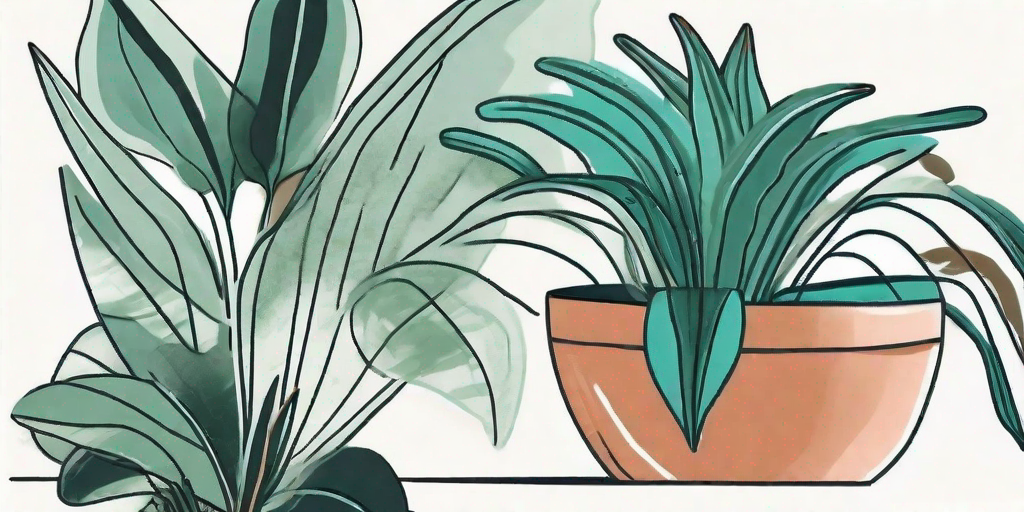
Lobster Claw Plant, scientifically known as Heliconia rostrata, is a tropical beauty that's sure to turn heads and spark conversations. With its unique, vibrant flowers that resemble the claws of a lobster, it's no wonder this plant has been given such a quirky name. But don't worry, it won't pinch!
Understanding the Lobster Claw Plant
The Lobster Claw Plant is native to the tropical rainforests of Central and South America. It's a perennial plant, meaning it can live for more than two years, and in the right conditions, it can reach up to 8 feet tall. Now that's a big lobster!
The plant's most striking feature is its flowers. They hang in clusters, with each individual flower looking like a lobster's claw. These flowers are usually red, but can also be yellow, orange, or pink. The plant also has large, glossy green leaves that add to its tropical appeal.
Why Grow a Lobster Claw Plant?
Well, aside from the fact that it's probably the closest thing to having a pet lobster without the need for a tank or seafood dinners, the Lobster Claw Plant is a great addition to any garden or indoor space. It's a real showstopper, and it's sure to be a conversation starter.
Plus, it's not just about looks. The Lobster Claw Plant is also known for its air-purifying qualities. It can help to remove toxins from the air, making your home or garden a healthier place to be. Now that's a plant with benefits!
How to Grow and Care for Your Lobster Claw Plant
So, you're hooked and want to get your claws on a Lobster Claw Plant? Great choice! But before you dive in, it's important to understand how to properly care for this unique beauty.
Remember, the Lobster Claw Plant is a tropical plant. It loves warm, humid conditions. So, if you live in a colder climate, you might want to consider growing your plant indoors or in a greenhouse.
Light and Temperature Requirements
The Lobster Claw Plant loves the sun, but it doesn't like to be in direct sunlight all day. A spot with partial shade is ideal. As for temperature, this plant prefers it warm. Try to keep the temperature above 60 degrees Fahrenheit.
Indoors, place your plant near a window where it can get plenty of indirect sunlight. If the temperature in your home tends to be on the cooler side, consider using a space heater or a heat mat to keep your plant warm.
Watering and Feeding
When it comes to watering, the Lobster Claw Plant likes to stay moist but not waterlogged. Water your plant thoroughly, then let the top inch of soil dry out before watering again.
As for feeding, a slow-release fertilizer applied in the spring and summer will keep your plant happy and healthy. Just remember, it's better to under-feed than over-feed. Too much fertilizer can cause leaf burn.
Common Problems and How to Solve Them
Like all plants, the Lobster Claw Plant can encounter a few issues. But don't worry, with a little TLC, your plant can overcome these obstacles.
Brown Leaves
If the leaves of your Lobster Claw Plant are turning brown, it could be a sign of underwatering or low humidity. Try increasing the frequency of watering and misting the leaves to increase humidity.
If the problem persists, consider moving your plant to a more humid environment, like a bathroom or a greenhouse.
Yellow Leaves
Yellow leaves can be a sign of overwatering or poor drainage. Make sure your plant's pot has good drainage, and avoid letting your plant sit in water.
If overwatering is not the issue, yellow leaves could also be a sign of a nutrient deficiency. In this case, a balanced, slow-release fertilizer can help.
Frequently Asked Questions
- Can I grow a Lobster Claw Plant from a cutting?
Yes, you can propagate a Lobster Claw Plant from a cutting. Just make sure the cutting is taken from a mature plant and has at least one node (the point where a leaf or branch is attached). - Is the Lobster Claw Plant toxic to pets?
No, the Lobster Claw Plant is not known to be toxic to pets. However, it's always a good idea to keep plants out of reach of curious pets. - How often does the Lobster Claw Plant flower?
With proper care, the Lobster Claw Plant can flower year-round. However, it's most likely to flower in the spring and summer.
Conclusion
So there you have it, a comprehensive guide to growing and caring for the unique and beautiful Lobster Claw Plant. With its striking flowers and air-purifying qualities, it's a plant that offers both beauty and function.
Whether you're a seasoned gardener or a newbie, the Lobster Claw Plant is a great addition to your plant collection. So why not get hooked and add this tropical beauty to your home or garden? Just remember, no butter or lemon juice required!















